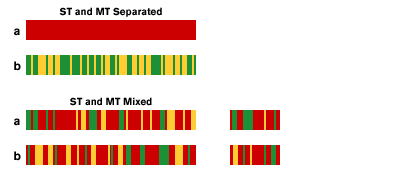Fragmentation of Labor
There are certain occupations that are inherently multi-tasking (MT), while others are inherently single-tasking (ST). Examples of single-tasking occupations (STO) are: medical surgeons, computer programmers, film editors, and writers in general. Multi-tasking occupations (MTO) are: project managers, sales persons, nurses, and technical support persons. In the last few years, I have come to believe that we have natural inclination for choosing MTO or STO, and that understanding these qualities in people is the key to effectively managing human resources and projects. What follows is an Yin/Yang analysis of STO and MTO.
MTO is inherently passive and STO active. (This incidentally matches the traditional Yin/Yang analysis of female/passive and male/active, and the recent scientific discovery of women being better at multi-tasking.) What I mean by passive is that an MTO is largely driven by external forces. Needs and situations come up beyond the control of an MTO person, and he/she is expected to deal with them on the as-they-come basis. In contrast, an STO person must be in control of the task at hand. MTO therefore is unpredictable and STO predictable. In fact, an important aspect of STO is that one must be able to predict to a certain degree the time span of the task. For instance, if you are a programmer, you must be able to reasonably predict how long it would take for you to write a specific function. This allows a project manager to set and meet a deadline. An MTO person, on the other hand, cannot predict what may come up within a course of a day.
Exhibit A

No one’s job can consist of 100 percent STO. There are always some interruptions. Exhibit A illustrates the degree to which STO can be fragmented. The blue areas indicate single tasking duties, the black areas indicate multi-tasking duties, and the gray areas indicate idle time. The bars on the right indicate the ratios.
Bar “a” is the ideal scenario for any STO persons. You only see a few interruptions within a day. Bar “b” is less ideal with many interruptions. Bar “c” is the point at which single-tasking duty is no longer manageable by this person because of frequent interruptions, and the ST areas are supplanted by idle time. This happens because certain criteria needed for STO cannot be fulfilled in this fashion. The most significant criterion for STO is predictability. If the predictability of a duty cannot be managed, e.g., if deadlines cannot be managed, the duty itself would become impractical.
In terms of the use of time, since so much of MTO’s duties arise out of our own control, it can never be perfectly efficient. This is why many managers and secretaries often appear to be doing nothing. However, in exchange for their idle time, they must not be forgetful. One of the responsibilities of MTO is to be aware of what is going on, and to remind others (especially STO persons) of significant events. Since STO persons are expected to be fully focused on their tasks at hand, they tend to be forgetful of anything else. In this sense, having idle time is an important aspect of an MTO; it gives them time to step back for a second and see the larger picture.
Exhibit B

The top half of Exhibit B illustrates a situation where ST and MT are effectively separated into corresponding STO and MTO persons. (The red area is ST, and the green and the yellow areas indicate MT.) The bottom half of Exhibit B shows what happens when you try to share ST and MT duties between the two persons; the same amount of work spreads over to the next day. This occurs because ST duties cannot efficiently be fragmented. Every time an interruption happens, you must reorient yourself when you get back to it. Things can be forgotten. Your thoughts or ideas can be lost. Your energy level may shift. The interruption may continue to affect your thoughts or emotion. All these can add up to cause a significant delay in schedule.
This analysis of ST and MT defines the extremes of the situation. It is not practically possible to cleanly separate ST and MT into two persons in this manner. However, the important point is that the more you make the effort to separate them, the more efficient your use of time would be. For instance, if there are only two persons in your office, you may achieve a better use of time by one person trying to shield the other from MT duties, such as phone calls, meetings, and general office maintenance. And at the same time, if there are any ST duties such as writing, planning, and budgeting, you should try to give as much of it to the STO person as possible. Even if the STO person is not fully capable of it, it is probably more efficient to let him/her draft the duty pending final approval by you. Eventually each person will become more adept at their own duties, and the separation of MT and ST will become more effective.
Subscribe
Occasionally I email you when I post a new article or if I have a question for my readers.


